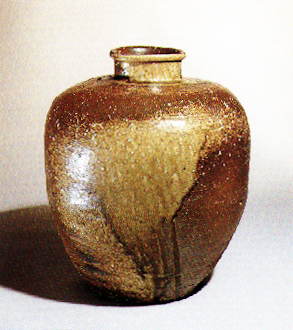
Shigaraki ware seed jar, stoneware
Japan, Muromachi Period, ca. 1500 CE, 13.8" height
ART 198 - HISTORY OF WORLD CERAMICS
| Shigaraki ware, from the province of Shiga, is one of the famous '6 Ancient Kilns' of Japan. While the ceramics of Japan certainly owe a debt to those of China, Japanese pottery has distinctive stylistic differences. Note that the shape is not perfectly symmetrical, and instead is softly and casually formed. The native clay of Shiga is allowed to show its unique qualities. Shiga clay is full of raw chunks of native feldspar, which during the long, hot stoneware firing in the Anagama (tunnel) kiln, would melt out to the surface, blending with the falling wood ash circulating in the kiln to form a natural, and quite runny, glaze. This accumulation of falling ash and chunks of feldspar can clearly be seen on the shoulder of this seed jar. One of the characteristics of much of Japanese folk pottery is this avoidance of applied decoration. Instead, the natural properties of the clay, glaze, and firing process account for the surface interest. Forms such as this are usually called seed jars, for their function as vessels to store seeds for the following year's planting. | Shigaraki ware seed jar, stoneware Japan, Muromachi Period, ca. 1500 CE, 13.8" height |
|
|